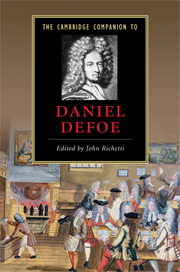Book contents
- Frontmatter
- Introduction
- 1 Defoe: the man in the works
- 2 Defoe’s political and religious journalism
- 3 Defoe, commerce, and empire
- 4 Defoe and criminal fiction
- 5 Money and character in Defoe’s fiction
- 6 Defoe’s Tour and the identity of Britain
- 7 Defoe as narrative innovator
- 8 Gender and fiction in Moll Flanders and Roxana
- 9 Defoe and London
- 10 Robinson Crusoe: varieties of fictional experience
- 11 Defoe: satirist and moralist
- 12 Defoe and poetic tradition
- Further Reading
- Index
1 - Defoe: the man in the works
Published online by Cambridge University Press: 28 March 2009
- Frontmatter
- Introduction
- 1 Defoe: the man in the works
- 2 Defoe’s political and religious journalism
- 3 Defoe, commerce, and empire
- 4 Defoe and criminal fiction
- 5 Money and character in Defoe’s fiction
- 6 Defoe’s Tour and the identity of Britain
- 7 Defoe as narrative innovator
- 8 Gender and fiction in Moll Flanders and Roxana
- 9 Defoe and London
- 10 Robinson Crusoe: varieties of fictional experience
- 11 Defoe: satirist and moralist
- 12 Defoe and poetic tradition
- Further Reading
- Index
Summary
One of Daniel Defoe's contemporaries, Eliza Haywood, opens The Invisible Spy (1755) by taunting the reader: “I have observed that when a new book begins to make a noise in the world ... every one is desirous of becoming acquainted with the author; and this impatience increases the more ... he endeavors to conceal himself.” Shortly before her death, Haywood “laid a solemn injunction” to keep her secrets on the person who knew her life best, because she believed “improper liberties [would be] taken with her character after death, by the intermixture of truth and falsehood.” Almost from the beginning of his writing career, Defoe could serve as proof of these statements. Although his contemporaries often wanted to “become acquainted with the author” in order to get him arrested, many of his modern-day biographers and critics have dedicated themselves to scrutinizing the works to find the man. Most people think that a writer can be found in the works and that “writing was his/her life.” The writer, however, was a material body, a mortal body. Defoe stood in the rain in the pillory and could not brush the water off his nose. Although he obviously had an excellent constitution and unusual stamina, he had colds, bruises, and surgery. People responded to his material body in ways that affected his behavior and self-perception; they remembered his hooked nose, his habit of crooking his little finger, and his foppishness. Writing was not Defoe's life. Unlike most writers, for whom “life” and its demands are obstacles to writing, except for the brief period of Defoe's poetic aspirations, he preferred life and resorted to writing when enraged, unoccupied, or in economic need.
- Type
- Chapter
- Information
- The Cambridge Companion to Daniel Defoe , pp. 5 - 24Publisher: Cambridge University PressPrint publication year: 2009
- 1
- Cited by

